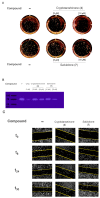Salviolone from Salvia miltiorrhiza Roots Impairs Cell Cycle Progression, Colony Formation, and Metalloproteinase-2 Activity in A375 Melanoma Cells: Involvement of P21(Cip1/Waf1) Expression and STAT3 Phosphorylation
- PMID: 35163058
- PMCID: PMC8835475
- DOI: 10.3390/ijms23031121
Salviolone from Salvia miltiorrhiza Roots Impairs Cell Cycle Progression, Colony Formation, and Metalloproteinase-2 Activity in A375 Melanoma Cells: Involvement of P21(Cip1/Waf1) Expression and STAT3 Phosphorylation
Abstract
Melanoma is a highly malignant solid tumor characterized by an elevated growth and propagation rate. Since, often, melanoma treatment cannot prevent recurrences and the appearance of metastasis, new anti-melanoma agents need to be discovered. Salvia miltiorrhiza roots are a source of diterpenoid derivatives, natural compounds with several biological activities, including antiproliferative and anticancer effects. Seven diterpenoid derivatives were purified from S. miltiorrhiza roots and identified by NMR and MS analysis. Tanshinone IIA and cryptotanshinone were detected as the main components of S. miltiorrhiza root ethanol extract. Although their antitumor activity is already known, they have been confirmed to induce a reduction in A375 and MeWo melanoma cell growth. Likewise, salviolone has been shown to impair the viability of melanoma cells without affecting the growth of normal melanocytes. The underlying anticancer activity of salviolone has been investigated and compared to that of cryptotanshinone in A375 cells, showing an increased P21 protein expression in a P53-dependent manner. In that way, salviolone, even more than cryptotanshinone, displays a multitarget effect on cell-cycle-related proteins. Besides, it modulates the phosphorylation level of the signal transducer and activator of transcription (STAT)3. Unexpectedly, salviolone and cryptotanshinone induce sustained activation of the extracellular signal-regulated kinases (ERK)1/2 and the protein kinase B (Akt). However, the blockage of ERK1/2 or Akt activities suggests that kinase activation does not hinder their ability to inhibit A375 cell growth. Finally, salviolone and cryptotanshinone inhibit to a comparable extent some crucial malignancy features of A375 melanoma cells, such as colony formation in soft agar and metalloproteinase-2 activity. In conclusion, it has been shown for the first time that salviolone, harboring a different molecular structure than tanshinone IIA and cryptotanshinone, exhibits a pleiotropic effect against melanoma by hampering cell cycle progression, STAT3 signaling, and malignant phenotype of A375 melanoma cells.
Keywords: Akt; Cdk2; ERK1/2; P53; cryptotanshinone; cyclin A2; diterpenoids; retinoblastoma protein; tanshinone IIA.
Conflict of interest statement
The authors declare no conflict of interest.
Figures






Similar articles
-
Proapoptotic and TRAIL-sensitizing constituents isolated from Salvia militiorrhiza (Danshen).J Biosci Bioeng. 2013 Oct;116(4):516-23. doi: 10.1016/j.jbiosc.2013.04.015. Epub 2013 May 7. J Biosci Bioeng. 2013. PMID: 23660075
-
Apoptosis induced by the methanol extract of Salvia miltiorrhiza Bunge in non-small cell lung cancer through PTEN-mediated inhibition of PI3K/Akt pathway.J Ethnopharmacol. 2017 Mar 22;200:107-116. doi: 10.1016/j.jep.2016.12.051. Epub 2017 Jan 12. J Ethnopharmacol. 2017. PMID: 28088493
-
Comparative pharmacokinetics and tissue distribution of cryptotanshinone, tanshinone IIA, dihydrotanshinone I, and tanshinone I after oral administration of pure tanshinones and liposoluble extract of Salvia miltiorrhiza to rats.Biopharm Drug Dispos. 2020 Feb;41(1-2):54-63. doi: 10.1002/bdd.2213. Epub 2020 Jan 22. Biopharm Drug Dispos. 2020. PMID: 31943245
-
A review of the biological activity and pharmacology of cryptotanshinone, an important active constituent in Danshen.Biomed Pharmacother. 2021 May;137:111332. doi: 10.1016/j.biopha.2021.111332. Epub 2021 Feb 4. Biomed Pharmacother. 2021. PMID: 33548911 Review.
-
Pharmacological properties of tanshinones, the natural products from Salvia miltiorrhiza.Adv Pharmacol. 2020;87:43-70. doi: 10.1016/bs.apha.2019.10.001. Epub 2020 Jan 13. Adv Pharmacol. 2020. PMID: 32089238 Review.
Cited by
-
Anti-inflammatory Activity of Tanshinone-Related Diterpenes from Perovskia artemisioides Roots.J Nat Prod. 2023 Apr 28;86(4):812-821. doi: 10.1021/acs.jnatprod.2c01004. Epub 2023 Apr 11. J Nat Prod. 2023. PMID: 37040078 Free PMC article.
-
Proliferation and Invasion of Melanoma Are Suppressed by a Plant Protease Inhibitor, Leading to Downregulation of Survival/Death-Related Proteins.Molecules. 2022 May 5;27(9):2956. doi: 10.3390/molecules27092956. Molecules. 2022. PMID: 35566311 Free PMC article.
-
A Review of Cryptotanshinone and its Nanoformulation in Cancer Therapy.Anticancer Agents Med Chem. 2025;25(16):1188-1197. doi: 10.2174/0118715206372305250319064431. Anticancer Agents Med Chem. 2025. PMID: 40176695 Review.
-
Metabolomics and network analysis reveal the mechanism of Salvia miltiorrhiza bunge extract in ameliorating cognitive dysfunction in sleep-deprived rats.Sci Rep. 2025 Aug 7;15(1):28873. doi: 10.1038/s41598-025-14303-6. Sci Rep. 2025. PMID: 40775015 Free PMC article.
-
The mechanisms of tanshinone in the treatment of tumors.Front Pharmacol. 2023 Oct 26;14:1282203. doi: 10.3389/fphar.2023.1282203. eCollection 2023. Front Pharmacol. 2023. PMID: 37964867 Free PMC article. Review.
References
MeSH terms
Substances
Grants and funding
LinkOut - more resources
Full Text Sources
Medical
Research Materials
Miscellaneous

